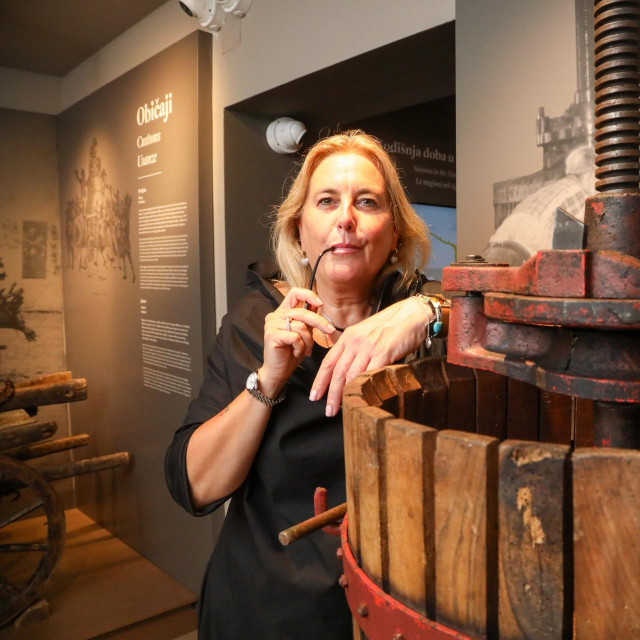In the old core of Pula, in the building of the former bank on Sergijevaca Street, the Istrian Wine Museum has opened, a cultural-tourist project that presents the region‘s rich wine heritage in a modern and interactive way. Behind the museum are two families, Otočan and Kostadinov, a friendship that grew into a partnership. Alongside Doris, Oriana, and Toni Otočan, there are Aleksandar Kostadinov and Olivera Međugorac, with the cooperation of numerous experts and institutions.
On about 300 square meters, in the immediate vicinity of the Forum, visitors can follow the development of viticulture and winemaking from ancient times to the present day. The exhibition features original items from the Archaeological Museum of Istria, the Ethnographic Museum, the Historical and Maritime Museum, and the Institute for Agriculture and Tourism from Poreč: Roman amphorae, glasses and bottles, old tools, presses, barrels, and photographs.
There are also items from the private collection owned by the Otočan family and their friends and acquaintances, related to Istrian viticulture and winemaking. Special emphasis is placed on historical documents such as the work of Pietro Stanković Vino dell‘Istria from 1853, and the debtor‘s book of Gašpar Červar, in which interest was repaid with teran wine, prosciutto, and olive oil.
Interactive Content and a Modern Approach
The museum also offers numerous multimedia features: visitors can participate in interactive presentations, hear the sounds of vineyards, listen to songs dedicated to wine, or in the sensory room, recognize scents such as honey, coffee, and flowers. At the center of the exhibition is an installation displaying four types of Istrian soil: red, white, gray, and black earth, and a sculpture made from a century-old teran vine from the vineyard of Josip Brečević Pepi.
"We wanted to combine tradition and modernity, to show wine not only through objects but also through music, scent, and touch," says Doris Cerin Otočan, one of the project initiators. "The museum arose from a love of wine, but also from the desire for Istria to have a place that would scientifically present its wine story."
One of the most striking parts of the exhibition is the "wine wall," a wall of wine where Istrian winemakers are presented, each with a single bottle. It serves as a kind of catalog of the Istrian wine scene, allowing visitors to get to know the cellars and labels through interactive points.
"Here, visitors and winemakers meet—some get the opportunity for promotion, while others get to know the best that Istria has to offer," explains Cerin Otočan.
Indigenous Varieties and Education
The museum presents in detail local varieties—malvasia, teran, borgonja, momjanski muscat, duranija, and hrvatic—and shows how soil, climate, and the work of winemakers shape their character. The educational part includes demonstrations of vineyard work through the four seasons, as well as the processes of wine production and storage.
"Malvasia and teran are our pillars, but it is equally important to remind people of lesser-known varieties that testify to Istria‘s diversity. Identity is not built only on bestsellers, but also on diversity," emphasizes Doris Cerin Otočan.
Special attention is drawn to historical anecdotes. One of them tells of the Istrian king Epulon and his warriors, who, according to legend, were defeated by the Romans because they fell asleep after drinking. Although historians debate its truth, the story shows the important role wine played in the lives of the Histri.
The museum also displays a document from the 19th century, stating that Pietro Stanković was the first to clearly demonstrate how viticulture could be the foundation of Istria‘s economic sustainability.
"We wanted to show that wine is not only about agriculture, but also about economy, culture, and identity. In the debt books, you can see that interest was calculated in teran, which clearly speaks to its value," adds Cerin Otočan.
In addition to the permanent exhibition, the Istrian Wine Museum also offers tastings. The entrance fee is 12 euros and includes tasting of malvasia, teran, or muscat. Plans include sommelier tours, workshops for children and schools, art and literary programs, and actress Petra Blašković will perform costumed storytelling dedicated to wine twice a week.
"Our goal is for the museum not to be a static collection, but a living space for meetings and education. We want to host workshops, promotions, cultural events here, and to attract an audience that may not primarily be wine-oriented, but is curious," says Cerin Otočan.
A Joint Project of the Private and Public Sectors
More than twenty experts participated in the realization of the museum, from historian Branimir Červar to designer Dražen Tomić and conservator Vitomir Žarković. The exhibition was curated by Tamara Nikolić Đerić, and the architectural design was done by Luka Matticchio. Support was provided by Vinistra, the Croatian Sommelier Club, and numerous winemakers.
At the grand opening, it was emphasized that this is a unique cultural-tourist attraction that complements Pula‘s Olive Oil Museum and significantly enriches the offerings of the city and region.
The Istrian Wine Museum connects history and modernity, tradition and multimedia, knowledge and enjoyment. With its interactive exhibition and rich collaborative network, it positions Pula as a new cultural center and confirms Istria as a region whose identity is deeply rooted in the vine.
"If, after the tour, a visitor reaches for a glass of wine with more understanding and respect, we will know we have done a good job," concludes Doris Cerin Otočan.













Za sudjelovanje u komentarima je potrebna prijava, odnosno registracija ako još nemaš korisnički profil....